Columbia under construction
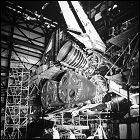 Construction begins on Space Shuttle Orbiter Vehicle 102 (OV-102 for short), the shuttle orbiter that NASA intends to launch as early as 1977. But OV-102 encounters the inherent pitfalls of being the first of its kind: years of delays are ahead, with many of the delays linked to the complicated system of protective thermal tiles designed to bear the brunt of the shuttle’s punishing re-entry through the atmosphere. (The test orbiter, later named Enterprise, is never intended for spaceflight, so it only has to conform to the shape and weight of a returning shuttle for landing tests, and therefore it doesn’t face the same hurdles.) OV-102’s first flight won’t take place until 1981, leaving a six-year gap between manned American spaceflights; during this period OV-102 will be named Columbia.
Construction begins on Space Shuttle Orbiter Vehicle 102 (OV-102 for short), the shuttle orbiter that NASA intends to launch as early as 1977. But OV-102 encounters the inherent pitfalls of being the first of its kind: years of delays are ahead, with many of the delays linked to the complicated system of protective thermal tiles designed to bear the brunt of the shuttle’s punishing re-entry through the atmosphere. (The test orbiter, later named Enterprise, is never intended for spaceflight, so it only has to conform to the shape and weight of a returning shuttle for landing tests, and therefore it doesn’t face the same hurdles.) OV-102’s first flight won’t take place until 1981, leaving a six-year gap between manned American spaceflights; during this period OV-102 will be named Columbia.

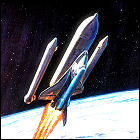 NASA prepares a preliminary schedule of Space Shuttle launches, covering the years 1979-1982 (and assuming the shuttle will be ready to launch in 1979). The ambitious schedule (which also assumes, in line with current planning, that the test orbiter Enterprise will be upgraded to spaceworthiness) includes almost-monthly flights from 1979 onward to deploy communications and weather satellites already on the drawing board, as well as frequent science missions with the cargo-bay-mounted Spacelab. On only the second test flight, the schedule has OV-102 (yet to be named Columbia) slated for a mission to the abandoned early 1970s space station Skylab, using a teleoperator retrieval system which also exists only on paper. While many of the schedule’s goals will be met, the delay in the shuttle program will be longer than NASA anticipates at this time.
NASA prepares a preliminary schedule of Space Shuttle launches, covering the years 1979-1982 (and assuming the shuttle will be ready to launch in 1979). The ambitious schedule (which also assumes, in line with current planning, that the test orbiter Enterprise will be upgraded to spaceworthiness) includes almost-monthly flights from 1979 onward to deploy communications and weather satellites already on the drawing board, as well as frequent science missions with the cargo-bay-mounted Spacelab. On only the second test flight, the schedule has OV-102 (yet to be named Columbia) slated for a mission to the abandoned early 1970s space station Skylab, using a teleoperator retrieval system which also exists only on paper. While many of the schedule’s goals will be met, the delay in the shuttle program will be longer than NASA anticipates at this time.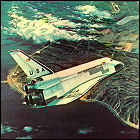 After several years of referring to the various Space Shuttle orbiters both under construction and in planning by numbers, NASA bestows names upon the anticipated fleet of four orbiters. OV-102, which is still expected to fly “late this year”, is named Columbia, while OV-099, undergoing conversion from a test article to flight-worthy vehicle, is named Challenger. Orbiters 103 and 104 will be named, respectively, Discovery and Atlantis; all four names are drawn from historical seafaring exploration vessels. (NASA has also used some of the names before: Columbia was the name of the moon-orbiting command module in the Apollo 11 mission, while Apollo 17’s lunar lander was named Challenger.)
After several years of referring to the various Space Shuttle orbiters both under construction and in planning by numbers, NASA bestows names upon the anticipated fleet of four orbiters. OV-102, which is still expected to fly “late this year”, is named Columbia, while OV-099, undergoing conversion from a test article to flight-worthy vehicle, is named Challenger. Orbiters 103 and 104 will be named, respectively, Discovery and Atlantis; all four names are drawn from historical seafaring exploration vessels. (NASA has also used some of the names before: Columbia was the name of the moon-orbiting command module in the Apollo 11 mission, while Apollo 17’s lunar lander was named Challenger.)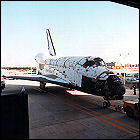 Space Shuttle Columbia is officially rolled out of the Rockwell International construction facility in Palmdale, California, even though her outer “skin” is still unfinished – NASA technicians continue working on perfecting the first spaceworthy shuttle’s thermal tiles for much of the next year, delaying the first launch until sometime in 1981 (just another in a series of delays for a vehicle that had been intended to fly as early as 1977).
Space Shuttle Columbia is officially rolled out of the Rockwell International construction facility in Palmdale, California, even though her outer “skin” is still unfinished – NASA technicians continue working on perfecting the first spaceworthy shuttle’s thermal tiles for much of the next year, delaying the first launch until sometime in 1981 (just another in a series of delays for a vehicle that had been intended to fly as early as 1977).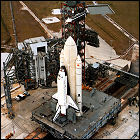 For the first time in the history of the delay-riddled Space Shuttle program, a complete, flight-ready vehicle is rolled out to the launch pad. Space Shuttle Columbia, atop the modified crawler vehicle which once carried Saturn V rockets to the pad, arrives at Cape Canaveral Launch Complex 39A, strapped to flight-qualified solid rocket boosters and a flight-ready external tank. (The shuttle Enterprise had been attached to empty boosters and tanks for fit checks as early as 1979.) Though preparation work continues to ready Columbia for flight, the shuttle is now in position for her first launch in 1981.
For the first time in the history of the delay-riddled Space Shuttle program, a complete, flight-ready vehicle is rolled out to the launch pad. Space Shuttle Columbia, atop the modified crawler vehicle which once carried Saturn V rockets to the pad, arrives at Cape Canaveral Launch Complex 39A, strapped to flight-qualified solid rocket boosters and a flight-ready external tank. (The shuttle Enterprise had been attached to empty boosters and tanks for fit checks as early as 1979.) Though preparation work continues to ready Columbia for flight, the shuttle is now in position for her first launch in 1981.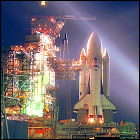 The first attempt to launch Space Shuttle Columbia on her maiden voyage is called off due to problems with the shuttle’s sophisticated system of redundant flight computers, some of which fail to synchronize with each other during the countdown. Over 24 hours are required to fix the bug, and the launch is delayed by two days.
The first attempt to launch Space Shuttle Columbia on her maiden voyage is called off due to problems with the shuttle’s sophisticated system of redundant flight computers, some of which fail to synchronize with each other during the countdown. Over 24 hours are required to fix the bug, and the launch is delayed by two days.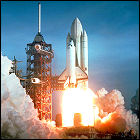
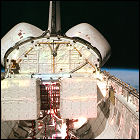 Safely in orbit, the cargo bay doors are opened for the first time on
Safely in orbit, the cargo bay doors are opened for the first time on 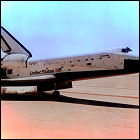 The first shuttle to return from space,
The first shuttle to return from space, 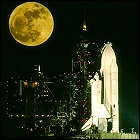 The second launch of Space Shuttle Columbia gets an unexpected one-month delay when a fuel leak forces NASA to remove, clean and re-attach 300 thermal tiles. The work can be done on-site, so Columbia simply stays on the pad. The second launch will be the last for the white external fuel tank, since NASA has determined that its brown insulating foam layer will cause no problems if left exposed; leaving off the coat of white paint saves several hundred pounds.
The second launch of Space Shuttle Columbia gets an unexpected one-month delay when a fuel leak forces NASA to remove, clean and re-attach 300 thermal tiles. The work can be done on-site, so Columbia simply stays on the pad. The second launch will be the last for the white external fuel tank, since NASA has determined that its brown insulating foam layer will cause no problems if left exposed; leaving off the coat of white paint saves several hundred pounds.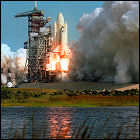 For the first time in history, a space vehicle returns to space for a second complete mission.
For the first time in history, a space vehicle returns to space for a second complete mission. 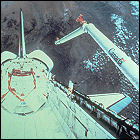 Key to NASA’s claim that the
Key to NASA’s claim that the 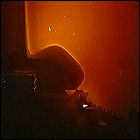 The testing phase of the shuttle program continues as Space Shuttle Columbia lifts off for her third flight into space. With Commander Jack Lousma and Pilot C. Gordon Fullerton aboard, Columbia stays in orbit for over a week, testing the orbiter’s endurance to heat at different angles to the sun, as well as testing the unmanned Spacelab experiment pallets in the cargo bay. This is the first shuttle flight to end on the contingency landing site at White Sands, New Mexico.
The testing phase of the shuttle program continues as Space Shuttle Columbia lifts off for her third flight into space. With Commander Jack Lousma and Pilot C. Gordon Fullerton aboard, Columbia stays in orbit for over a week, testing the orbiter’s endurance to heat at different angles to the sun, as well as testing the unmanned Spacelab experiment pallets in the cargo bay. This is the first shuttle flight to end on the contingency landing site at White Sands, New Mexico.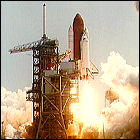 Space Shuttle Columbia lifts off for the fourth and final shuttle “test flight” before NASA’s Space Transportation System is declared fully operational. Remaining in orbit for a full week, Commander Ken Mattingly and Pilot Henry Hartsfield deliver the shuttle program’s first payload for the Department of Defense, as well as some of the first student-submitted experiment packages flown in the shuttle program. Both of Columbia’s solid rocket boosters, which are considered a reusable part of the launch vehicle, are lost at sea when their parachutes fail to deploy after separation and the boosters slam into the Atlantic Ocean; neither of the rockets are able to be recovered.
Space Shuttle Columbia lifts off for the fourth and final shuttle “test flight” before NASA’s Space Transportation System is declared fully operational. Remaining in orbit for a full week, Commander Ken Mattingly and Pilot Henry Hartsfield deliver the shuttle program’s first payload for the Department of Defense, as well as some of the first student-submitted experiment packages flown in the shuttle program. Both of Columbia’s solid rocket boosters, which are considered a reusable part of the launch vehicle, are lost at sea when their parachutes fail to deploy after separation and the boosters slam into the Atlantic Ocean; neither of the rockets are able to be recovered.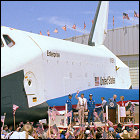 Space Shuttle Columbia lands at Edwards Air Force Base in California, making its first-ever landing on a concrete runway. After greeting the returning astronauts and inspecting the shuttle, President Ronald Reagan – with the partially-dismantled prototype Enterprise as a backdrop – declares NASA’s Space Shuttle system fully operational, saying “the test flights are over.” Columbia Commander Ken Mattingly later reveals that there was tremendous pressure on NASA to land Columbia on Independence Day, regardless of how many mission objectives had been met, to maximize the publicity value of the President’s speech. But the quick turnaround time and almost-weekly flight schedule that NASA had publicized throughout the 1970s is already a pipe dream: post-mission the four missions flown so far prove that post-landing servicing of each orbiter takes longer than expected. Columbia won’t fly again until the first “operational” mission in November.
Space Shuttle Columbia lands at Edwards Air Force Base in California, making its first-ever landing on a concrete runway. After greeting the returning astronauts and inspecting the shuttle, President Ronald Reagan – with the partially-dismantled prototype Enterprise as a backdrop – declares NASA’s Space Shuttle system fully operational, saying “the test flights are over.” Columbia Commander Ken Mattingly later reveals that there was tremendous pressure on NASA to land Columbia on Independence Day, regardless of how many mission objectives had been met, to maximize the publicity value of the President’s speech. But the quick turnaround time and almost-weekly flight schedule that NASA had publicized throughout the 1970s is already a pipe dream: post-mission the four missions flown so far prove that post-landing servicing of each orbiter takes longer than expected. Columbia won’t fly again until the first “operational” mission in November.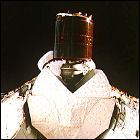 On the first fully-operational flight of NASA’s Space Transportation System, Space Shuttle Columbia delivers two commercial satellites to orbit, the Canadian Anik C-3 satellite and an American satellite, SitS-C. Aboard Columbia for this flight is the first four-astronaut crew in NASA’s history, consisting of Commander Vance Brand, Pilot Robert Overmyer, and mission specialists Joseph Allen and William Lenoir. The flight lasts five days before a landing at Edwards Air Force Base.
On the first fully-operational flight of NASA’s Space Transportation System, Space Shuttle Columbia delivers two commercial satellites to orbit, the Canadian Anik C-3 satellite and an American satellite, SitS-C. Aboard Columbia for this flight is the first four-astronaut crew in NASA’s history, consisting of Commander Vance Brand, Pilot Robert Overmyer, and mission specialists Joseph Allen and William Lenoir. The flight lasts five days before a landing at Edwards Air Force Base.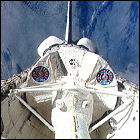 Returning to space after nearly a year of refits, Space Shuttle Columbia lifts off on the long-delayed first manned mission of the Spacelab laboratory module, which is installed in the cargo bay. (The nearly month-long delay was the result of a solid rocket booster issue that led to the first-ever return of the shuttle from the launch pad to the Vehicle Assembly Building.) The ten-day mission also boasts the first six-person shuttle crew, featuring the first Spacelab scientists from the European Space Agency, who have been training for this mission since the 1970s. Columbia’s crew includes Commander John Young, Pilot Brewster Shaw, mission specialists Owen Garriott and Robert Parker, and ESA payload specialists Byron Lichtenberg and Ulf Merbold.
Returning to space after nearly a year of refits, Space Shuttle Columbia lifts off on the long-delayed first manned mission of the Spacelab laboratory module, which is installed in the cargo bay. (The nearly month-long delay was the result of a solid rocket booster issue that led to the first-ever return of the shuttle from the launch pad to the Vehicle Assembly Building.) The ten-day mission also boasts the first six-person shuttle crew, featuring the first Spacelab scientists from the European Space Agency, who have been training for this mission since the 1970s. Columbia’s crew includes Commander John Young, Pilot Brewster Shaw, mission specialists Owen Garriott and Robert Parker, and ESA payload specialists Byron Lichtenberg and Ulf Merbold.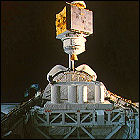 Space Shuttle Columbia lifts off on a six-day satellite deployment mission, and is also the first spaceflight to include a sitting member of the US Congress among its crew. The SATCOM KU-I satellite is launched, but another payload designed to observe Halley’s Comet (which is rapidly approaching its closest approach to Earth) malfunctions and collects no data. Columbia’s crew for this mission consists of Commander Robert Gibson, Pilot Charles Bolden, mission specialists Franklin Chang-Diaz, Steven Hawley, George Nelson, and payload specialists Robert Cenker and Congressman Bill Nelson.
Space Shuttle Columbia lifts off on a six-day satellite deployment mission, and is also the first spaceflight to include a sitting member of the US Congress among its crew. The SATCOM KU-I satellite is launched, but another payload designed to observe Halley’s Comet (which is rapidly approaching its closest approach to Earth) malfunctions and collects no data. Columbia’s crew for this mission consists of Commander Robert Gibson, Pilot Charles Bolden, mission specialists Franklin Chang-Diaz, Steven Hawley, George Nelson, and payload specialists Robert Cenker and Congressman Bill Nelson.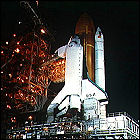 Lifting off on its first spaceflight since January 1986, Space Shuttle Columbia heads into orbit on a five-day classified Department of Defense mission. Columbia’s crew for this flight consists of Commander Brewster Shaw, Pilot Richard Richards, and mission specialists James Adamson, David Leestma and Mark Brown.
Lifting off on its first spaceflight since January 1986, Space Shuttle Columbia heads into orbit on a five-day classified Department of Defense mission. Columbia’s crew for this flight consists of Commander Brewster Shaw, Pilot Richard Richards, and mission specialists James Adamson, David Leestma and Mark Brown.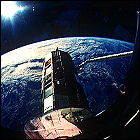 Space Shuttle Columbia lifts off on a ten-day mission to deploy the LEASAT 5 communications satellite and retrieve the Long Duration Exposure Facility satellite that had been placed in orbit in 1984 by Challenger. (LDEF retrieval, delayed from 1985, had been put off by several additional years by the Challenger accident and its aftermath.) Aboard Columbia in this flight are Commander Daniel Brandenstein, Pilot James Wetherbee, and mission specialists Bonnie Dunbar, G. David Low, and Marsha Ivins.
Space Shuttle Columbia lifts off on a ten-day mission to deploy the LEASAT 5 communications satellite and retrieve the Long Duration Exposure Facility satellite that had been placed in orbit in 1984 by Challenger. (LDEF retrieval, delayed from 1985, had been put off by several additional years by the Challenger accident and its aftermath.) Aboard Columbia in this flight are Commander Daniel Brandenstein, Pilot James Wetherbee, and mission specialists Bonnie Dunbar, G. David Low, and Marsha Ivins.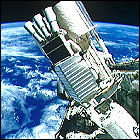 Space Shuttle Columbia lifts off for an eight-day mission to become a manned space telescope in Earth orbit, carrying the ASTRO-1 package designed to conduct X-ray and ultraviolet astronomy, mounted on an unmanned Spacelab pallet in the cargo bay. The mission has been delayed for months, most notably by hydrogen leaks detected long before the original May launch date. Manning Columbia for this flight are Commander Vance Brand, Pilot Guy Gardner, mission specialists Jeffrey Hoffman, John Lounge and Robert Parker, and payload specialists Samuel Durrance and Ronald Parise.
Space Shuttle Columbia lifts off for an eight-day mission to become a manned space telescope in Earth orbit, carrying the ASTRO-1 package designed to conduct X-ray and ultraviolet astronomy, mounted on an unmanned Spacelab pallet in the cargo bay. The mission has been delayed for months, most notably by hydrogen leaks detected long before the original May launch date. Manning Columbia for this flight are Commander Vance Brand, Pilot Guy Gardner, mission specialists Jeffrey Hoffman, John Lounge and Robert Parker, and payload specialists Samuel Durrance and Ronald Parise. 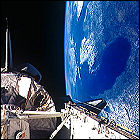 Space Shuttle Columbia lifts off on a nine-day mission with – for the first time in the shuttle program – a crew that’s nearly 50% female. Columbia carries the Spacelab module into orbit for a series of life sciences and biology experiments, the first flight devoted to such experiments since the Skylab era. Aboard Columbia for this flight are Commander Bryan O’Connor, Pilot Sidney Gutierrez, and mission specialists James Bagian, Tamara Jernigan, Rhea Seddon, Drew Gaffney and Millie Hughes-Fulford.
Space Shuttle Columbia lifts off on a nine-day mission with – for the first time in the shuttle program – a crew that’s nearly 50% female. Columbia carries the Spacelab module into orbit for a series of life sciences and biology experiments, the first flight devoted to such experiments since the Skylab era. Aboard Columbia for this flight are Commander Bryan O’Connor, Pilot Sidney Gutierrez, and mission specialists James Bagian, Tamara Jernigan, Rhea Seddon, Drew Gaffney and Millie Hughes-Fulford.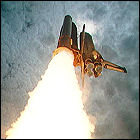 NASA launches Space Shuttle Columbia on the 48th shuttle mission (Columbia’s 12th trip into orbit). Using the Spacelab module, Columbia’s crew conducted the first USML (United States Microgravity Laboratory) flight, as well as testing a new system called the EDO (Extended Duration Orbiter) package, allowing the crew to stay in orbit longer than any previous shuttle (or, for that matter, lunar) flight. Aboard Columbia for the record-breaking 13-and-a-half-day mission are Commander Richard N. Richards, Pilot Ken Bowersox, Payload Commander Bonnie Dunbar, mission specialists Ellen Baker and Carl Meade, and payload specialists Lawrence DeLucasand Eugene Trinh.
NASA launches Space Shuttle Columbia on the 48th shuttle mission (Columbia’s 12th trip into orbit). Using the Spacelab module, Columbia’s crew conducted the first USML (United States Microgravity Laboratory) flight, as well as testing a new system called the EDO (Extended Duration Orbiter) package, allowing the crew to stay in orbit longer than any previous shuttle (or, for that matter, lunar) flight. Aboard Columbia for the record-breaking 13-and-a-half-day mission are Commander Richard N. Richards, Pilot Ken Bowersox, Payload Commander Bonnie Dunbar, mission specialists Ellen Baker and Carl Meade, and payload specialists Lawrence DeLucasand Eugene Trinh.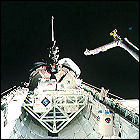 Space Shuttle Columbia lifts off on the shuttle program’s 51st flight, a ten-day mission to launch Laser Geodynamic Satellite II and the cargo-bay-mounted U.S. Microgravity Payload experiment package. Aboard Columbia for her 13th flight are Commander James Wetherbee, Pilot Michael Baker, mission specialists Charles Veach, William Shepherd and Tamara Jernigan, and payload specialist Steven MacLean.
Space Shuttle Columbia lifts off on the shuttle program’s 51st flight, a ten-day mission to launch Laser Geodynamic Satellite II and the cargo-bay-mounted U.S. Microgravity Payload experiment package. Aboard Columbia for her 13th flight are Commander James Wetherbee, Pilot Michael Baker, mission specialists Charles Veach, William Shepherd and Tamara Jernigan, and payload specialist Steven MacLean.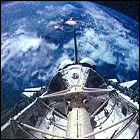 Space Shuttle Columbia lifts off on a mission lasting nearly ten days, carrying the Spacelab laboratory module in its cargo bay. This flight, Spacelab D-2, includes medical and material experiments, with one experiment controlled by an Apple Macintosh computer carried into orbit. Amateur radio messages are exchanged with the crew of the Mir space station. Aboard Columbia for her 14th flight are Commander Steven Nagel, Pilot Terence Henricks, mission specialists Jerry Ross, Charles Precourt and Bernard Harris Jr., and payload specialists Ulrich Walter and Hans Schlegel.
Space Shuttle Columbia lifts off on a mission lasting nearly ten days, carrying the Spacelab laboratory module in its cargo bay. This flight, Spacelab D-2, includes medical and material experiments, with one experiment controlled by an Apple Macintosh computer carried into orbit. Amateur radio messages are exchanged with the crew of the Mir space station. Aboard Columbia for her 14th flight are Commander Steven Nagel, Pilot Terence Henricks, mission specialists Jerry Ross, Charles Precourt and Bernard Harris Jr., and payload specialists Ulrich Walter and Hans Schlegel.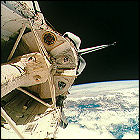 Space Shuttle Columbia is launched on the 58th shuttle mission, a two-week stay in orbit with the Spacelab module. This is the second Spacelab flight devoted to medical experiments and life sciences. Aboard Columbia for her 15th flight are Commander John Blaha, Pilot Richard Searfoss, mission specialists Rhea Seddon, William McArthur, David Wolf and Shannon Lucid, and payload specialist Martin Fettman.
Space Shuttle Columbia is launched on the 58th shuttle mission, a two-week stay in orbit with the Spacelab module. This is the second Spacelab flight devoted to medical experiments and life sciences. Aboard Columbia for her 15th flight are Commander John Blaha, Pilot Richard Searfoss, mission specialists Rhea Seddon, William McArthur, David Wolf and Shannon Lucid, and payload specialist Martin Fettman.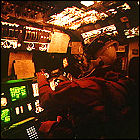 Space Shuttle Columbia lifts off on the 61st shuttle mission, a two-week visit to Earth orbit carrying two cargo-bay-mounted experiment systems operated primarily from the ground. Crew members participate in experiments involving the side-effects of long-term space travel. The crew for Columbia’s 16th flight consists of Commander John Casper, Pilot Andrew Allen, and mission specialists Pierre Thuot, Charles Gemar and Marsha Ivins.
Space Shuttle Columbia lifts off on the 61st shuttle mission, a two-week visit to Earth orbit carrying two cargo-bay-mounted experiment systems operated primarily from the ground. Crew members participate in experiments involving the side-effects of long-term space travel. The crew for Columbia’s 16th flight consists of Commander John Casper, Pilot Andrew Allen, and mission specialists Pierre Thuot, Charles Gemar and Marsha Ivins.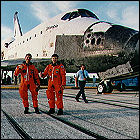 Space Shuttle Columbia is launched on the 63rd mission of the shuttle program. For two weeks, Columbia’s crew participates in the second IML (International Microgravity Laboratory) flight, conducting experiments relying on zero G around the clock. Columbia is also in orbit during the 25th anniversary of Apollo 11, the moon landing mission whose command/service module was also named Columbia. Aboard for Columbia’s 17th flight are Commander Robert Cabana, Pilot James Halsell, Payload Commander Richard Hieb, mission specialists Carl Walz, Leroy Chiao and Donald Thomas, and payload specialist Chiaki Naito-Mukai, the first Japanese woman in space.
Space Shuttle Columbia is launched on the 63rd mission of the shuttle program. For two weeks, Columbia’s crew participates in the second IML (International Microgravity Laboratory) flight, conducting experiments relying on zero G around the clock. Columbia is also in orbit during the 25th anniversary of Apollo 11, the moon landing mission whose command/service module was also named Columbia. Aboard for Columbia’s 17th flight are Commander Robert Cabana, Pilot James Halsell, Payload Commander Richard Hieb, mission specialists Carl Walz, Leroy Chiao and Donald Thomas, and payload specialist Chiaki Naito-Mukai, the first Japanese woman in space.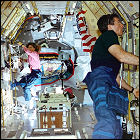 Space Shuttle Columbia is launched on the 72nd shuttle mission, and Columbia’s 18th visit to Earth orbit. Over a 16-day period, the Spacelab module mounted in the cargo bay hosts the second U.S. Microgravity Laboratory mission, with experiments conducted around the clock. The first pitch of the fifth game of the 1995 World Series is thrown aboard Columbia and broadcast live – the first time that the first pitch of a game took place somewhere other than the ballpark in question. Columbia is manned by Commander Kenneth Bowersox, Pilot Kent Rominger, Payload Commander Kathryn Thornton, mission specialists Catherine Coleman and Michael Lopez-Alegria, and payload specialists Fred Leslie and Albert Sacco.
Space Shuttle Columbia is launched on the 72nd shuttle mission, and Columbia’s 18th visit to Earth orbit. Over a 16-day period, the Spacelab module mounted in the cargo bay hosts the second U.S. Microgravity Laboratory mission, with experiments conducted around the clock. The first pitch of the fifth game of the 1995 World Series is thrown aboard Columbia and broadcast live – the first time that the first pitch of a game took place somewhere other than the ballpark in question. Columbia is manned by Commander Kenneth Bowersox, Pilot Kent Rominger, Payload Commander Kathryn Thornton, mission specialists Catherine Coleman and Michael Lopez-Alegria, and payload specialists Fred Leslie and Albert Sacco.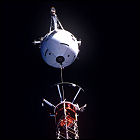 Space Shuttle Columbia is launched on the 75th shuttle flight, staying in orbit for nearly 16 days. The crew attempts to deploy a tethered satellite experiment flown unsuccessfully in 1992, only to watch as the tether snaps with the satellite 12 miles away from the shuttle. The remainder of the flight is spent conducting planned material science experiments. Aboard Columbia for her 19th flight are Commander Andrew Allen, Pilot Scott Horowitz, Payload Commander Franklin Chang-Diaz, and mission specialists Maurizio Cheli, Jeffrey Hoffman, Claude Nicollier and Umberto Guidoni. To this day, video of the satellite floating in space after the tether failure is circulated as “proof” of the existence of UFOs.
Space Shuttle Columbia is launched on the 75th shuttle flight, staying in orbit for nearly 16 days. The crew attempts to deploy a tethered satellite experiment flown unsuccessfully in 1992, only to watch as the tether snaps with the satellite 12 miles away from the shuttle. The remainder of the flight is spent conducting planned material science experiments. Aboard Columbia for her 19th flight are Commander Andrew Allen, Pilot Scott Horowitz, Payload Commander Franklin Chang-Diaz, and mission specialists Maurizio Cheli, Jeffrey Hoffman, Claude Nicollier and Umberto Guidoni. To this day, video of the satellite floating in space after the tether failure is circulated as “proof” of the existence of UFOs.